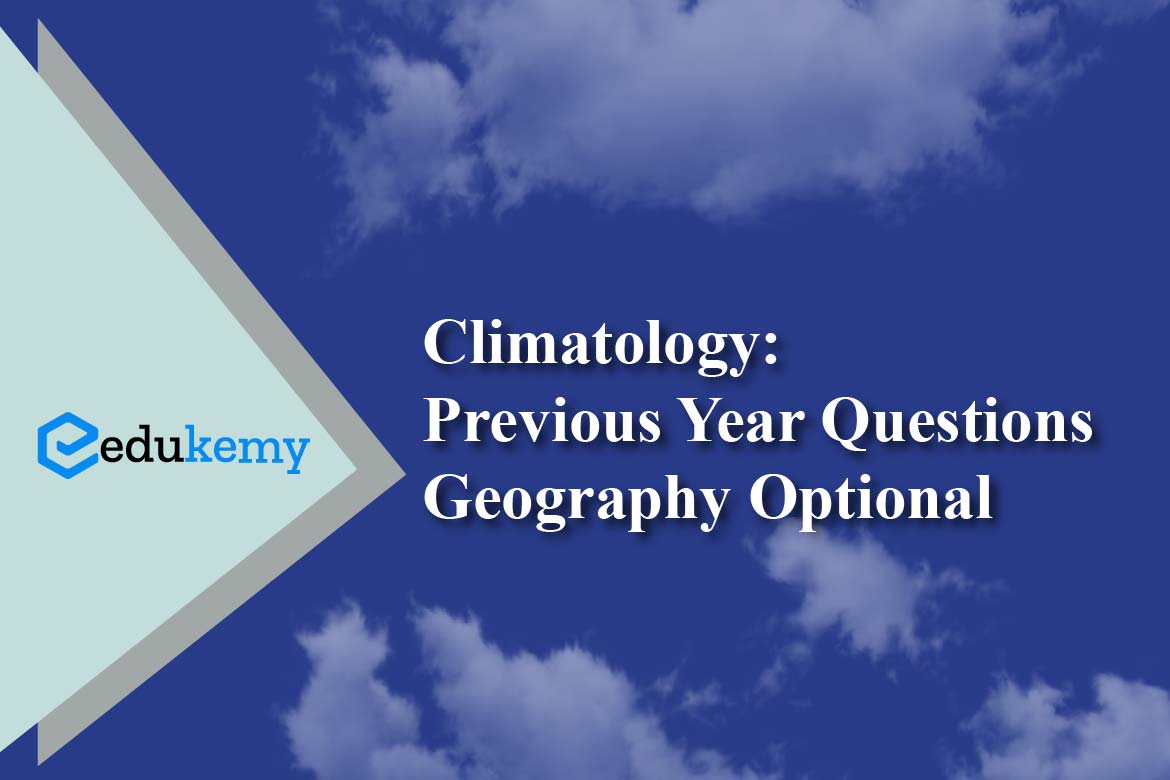Climatology is one of the important sections of Geography Optional for the UPSC Civil Services Mains Examination. Outlined below are the various questions asked in the UPSC Mains from Climatology.
Complete Syllabus for Geography Optional for UPSC CSE
Get the Geography Optional Hard Copy Notes of Shabbir Sir’s most recent batch: Here
Contents
- 1 Climatology Previous Year Questions (UPSC CSE Mains Geography Optional)
- 2 FAQs
- 2.1 1. FAQ: How can reviewing previous year question papers for Climatology optional help in exam preparation?
- 2.2 2. FAQ: Are there recurring topics in Climatology optional previous year question papers?
- 2.3 3. FAQ: How can solving previous year question papers improve my performance in the Climatology optional exam?
- 2.4 4. FAQ: Should I focus more on recent years’ Climatology optional question papers?
- 2.5 5. FAQ: Can solving Climatology optional previous year question papers serve as a revision strategy?
- 3 In case you still have your doubts, contact us on 9811333901.
Climatology Previous Year Questions (UPSC CSE Mains Geography Optional)
- What is a pollution dome? Discuss its formation and impacts. (10 Marks/2022)
- With suitable examples describe the impacts of the movement of air masses on weather and winds in different
parts of the continents. (15 Marks/2022) - The rise of surface temperature brings severe consequences. Elaborate on the potential changes and threats
associated with it in the world. (20 Marks/2022) - Describe how short-term variations in temperature are related to the processes of receiving energy from
the sun to the Earth’s surface and dissipating it to the atmosphere. (15 Marks/2022) - What are the important factors responsible for airmass modifications ? (10 Marks/2021)
- Examine major influencing factors for varied patterns of precipitations on the continents.(20 Marks/2021)
- Indicating the causes of lighting, describe the threats associated with it. (15 Marks/2021)
- Write a geographical note on Halloween Storm. (10 Marks/2020)
- Explain how various factors influence the origin and development of the Indian monsoon system.
(20 Marks/2020) - Explain the characteristic features of Frontogenesis and Frontolysis. (15 Marks/2020)
- Explain the techniques to calculate potential evapotranspiration suggested by Thornthwaite.
(10 Marks/2019) - Explain the nature of urban climates and their impact on global environmental change. (15 Marks/2019)
- Discuss in detail the tri-cellular model of atmospheric circulation. (20 Marks/2019)
- Explain the role of evaporation in the hydrologic cycle. (10 Marks/2018)
- Critically examine the basis and scheme of climatic classification proposed by G.T.Trewartha.
(15 Marks/2018) - Explain the origin, progress and retreat of the Indian monsoon and discuss its impact on the Indian
economy. (20 Marks/2018) - Discuss the forces which govern the air movement on the Earth’s surface. (20 Marks/2017)
- “Climate change is a reality.” Explain with suitable examples. (20 Marks/2017)
- Differential between insolation and temperature and explain anomalous temperature. (10 Marks/2016)
- Compare the origin and weather condition associated with the tropical and temperate cyclones.
(15 Marks/2016) - Discuss the significance of World Climate Research Programme (WCEF) and its core projects in the
understanding of climatic change. (20 Marks/2016) - Discuss as to how frontogenesis contributes to weather instability. (10 Marks/2015)
- What is Potential Evapotranspiration? Explain how it is used in assessing the water balance in an area.
(15 Marks/2015) - Discuss the basis of Koppen’s climatic classification of ‘Cs’ type of climate. (20 Marks/2015)
- Explain the meridional circulation of the atmosphere and its importance in world climate.
(15 Marks/2015) - Discuss the salient features of ‘sirocco’ and mistral’. (10 Marks/2014)

FAQs
1. FAQ: How can reviewing previous year question papers for Climatology optional help in exam preparation?
Answer: Reviewing previous year question papers for Climatology optional is essential as it provides insights into the exam pattern, question types, and the level of difficulty expected. Analyzing past papers helps candidates understand the areas of emphasis, allowing for more focused and strategic preparation. It also aids in time management during the actual exam by familiarizing candidates with the format and structure of questions.
2. FAQ: Are there recurring topics in Climatology optional previous year question papers?
Answer: Yes, there are recurring topics in Climatology optional previous year question papers. Climate classification, atmospheric circulation, and the impact of climate on various phenomena are often featured. Understanding these recurring themes helps candidates prioritize their study areas and ensures a comprehensive coverage of the syllabus.
3. FAQ: How can solving previous year question papers improve my performance in the Climatology optional exam?
Answer: Solving previous year question papers is a valuable practice that enhances exam preparedness. It helps in identifying weak areas, improving time management skills, and adapting to the exam’s style and difficulty. Regular practice with past papers also boosts confidence and allows candidates to gauge their progress, making them better equipped for the actual exam.
4. FAQ: Should I focus more on recent years’ Climatology optional question papers?
Answer: While it’s essential to cover a range of previous years, placing a slightly higher emphasis on recent years’ question papers is advisable. This ensures that candidates are aligned with the evolving trends and priorities of the examiners. However, a comprehensive approach that includes both recent and older papers provides a well-rounded understanding of the subject.
5. FAQ: Can solving Climatology optional previous year question papers serve as a revision strategy?
Answer: Absolutely. Solving previous year question papers serves as an effective revision strategy for Climatology optional. It consolidates knowledge, reinforces key concepts, and helps in retaining information in the long term. It also aids in identifying any gaps in understanding that may need additional attention before the actual exam. Regular revision through past papers contributes significantly to overall exam readiness.
In case you still have your doubts, contact us on 9811333901.
For UPSC Prelims Resources, Click here
For Daily Updates and Study Material:
Join our Telegram Channel – Edukemy for IAS
- 1. Learn through Videos – here
- 2. Be Exam Ready by Practicing Daily MCQs – here
- 3. Daily Newsletter – Get all your Current Affairs Covered – here
- 4. Mains Answer Writing Practice – here

